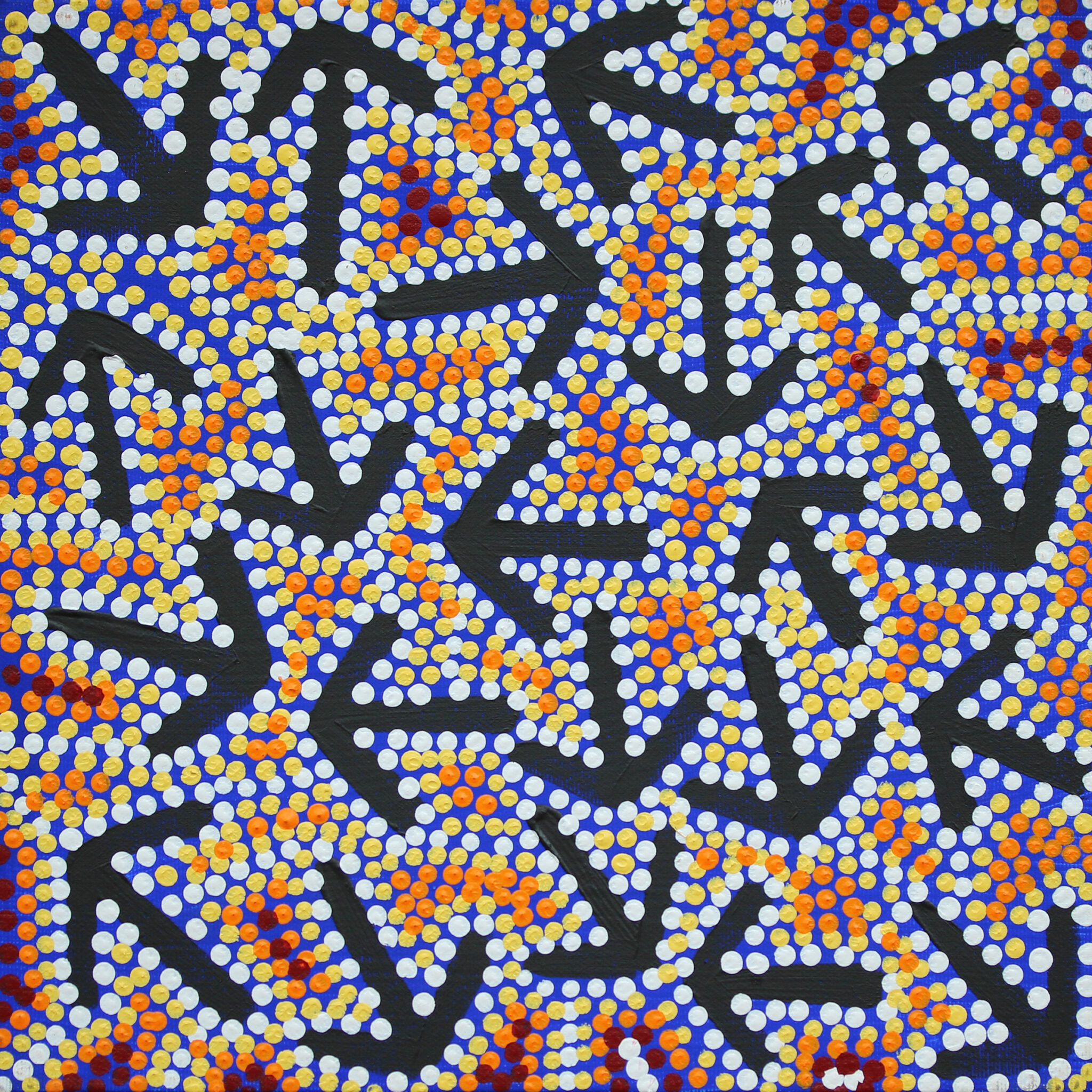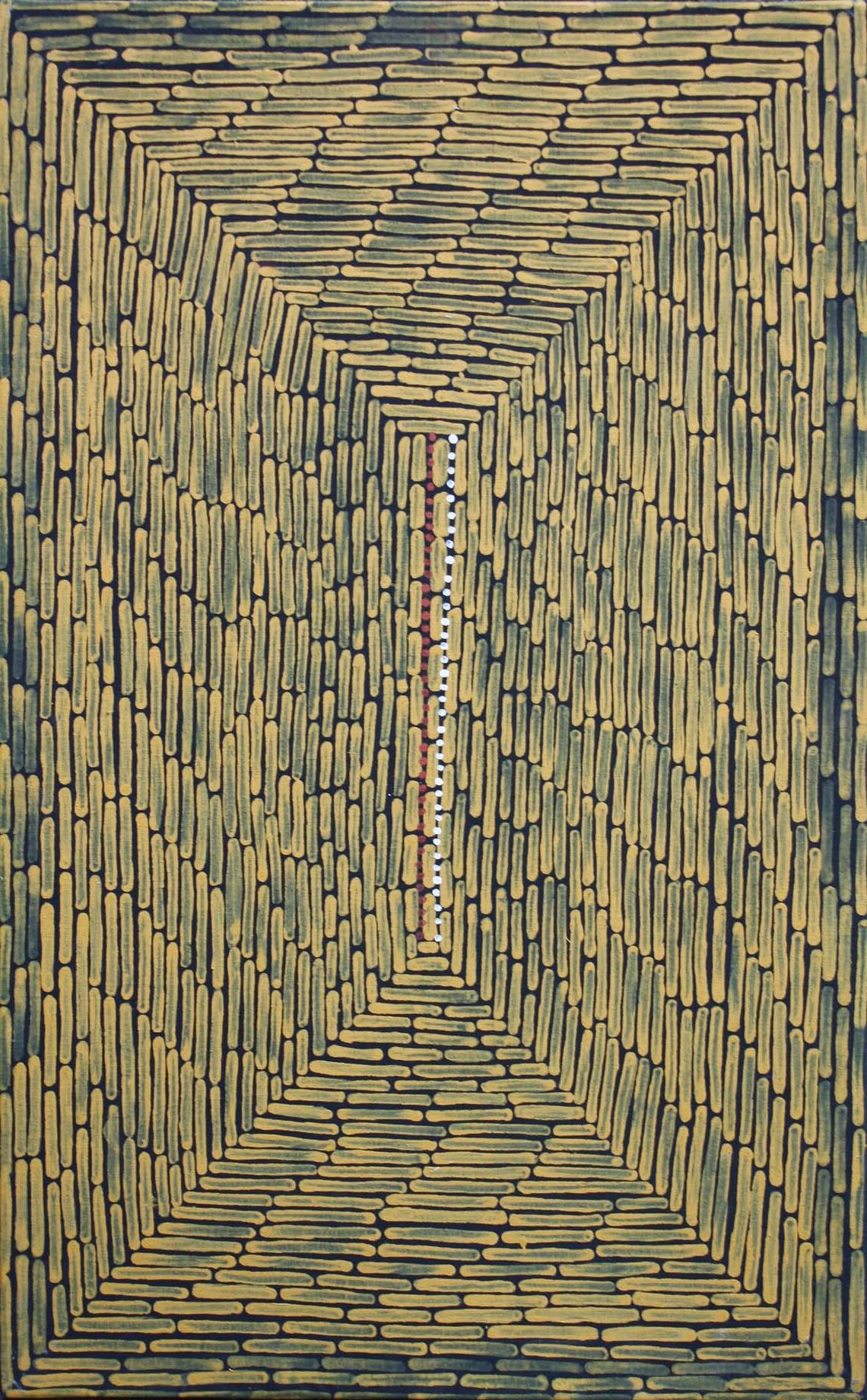Serial:
Size:
$1,682 (tax inc.)
SOLD
The story:
The painting tells the journey of Tare-nore’ Tare-nore who was also known as Wayler was a courageous Aboriginal resistance fighter. Tare-nore led the Plair-heke-hiller-plue, people a band that lived near Emu Bay in Tasmania The painting is the artist’s impression of Tare-nore’s resistance to the invasion of her homeland. The nine hills in the bottom of the painting represents the nine tribal Homelands of the Tasmanian Aboriginal people. The Oyster Bay, North East, North, Big River, North Midlands, Ben Lomond, North West, South West and the South East Tribes The various circles on the 9 hills represent the various clan groups (family groups) of each tribe. The U shapes represent people The painting describes scenes with which the young Aboriginal girl was presented. At first she saw her land and people free. Then she saw, from across the sea, new people arrive. Some were in chains, some had guns. These scenes to Tare-nore were at first symbols of curiosity and wonder, then symbols of destruction and despair. Tare-nore saw her people killed, their lands and hunting grounds invaded. The middle section of the painting represents white settlement of her people’s lands. The flag symbols represents British soldiers and settlers occupying and moving through her land. Tare-nor also saw and heard about many soldiers forming a line to hunt and round up her people – the infamous Black Line. Tare-nore could not stand by and let this destruction of her people go without resistance. The upper portion of the painting depicts Tare-nore’s travels and her resistance to her final captivity with her sister Noendapper on Gun Carriage Island where they both died within weeks of each other. The crosses represent the deaths of Aboriginal people and the desecration of their graves in the name of science. As a young girl Tarenore had been abducted and exchanged for dogs and flour to the sealers. After living with them for some years she escaped and became the leader of the Emu Bay people, whom she taught to use firearms. In 1830 whilst trying to escape capture from soldiers she was captured by two sealers and taken to an island in eastern Bass Strait. There she refused to work for the sealers, who then decided to isolate her on Penguin Island, but during the voyage there she attempted to kill them and would have succeded had not a soldier appeared. The sealers gave her up. She was taken to Swan Island and held captive with other Aboriginal women. Because of her continued resistance she was then taken to Gun Carraige Island where she finally met her sister who had also been captured by sealers at a young age. Both sisters were isolated from the rest of the women because of the fear that they would stir up the other women captives to escape from this desolate Island. The 2 black lines in the centre of the painting represents Govonor Arthurs Black line. On 1 November 1828 Govonor Arthur declared martial law against the Aborigines. This meant that the military had the right to apprehend with out warrant or to shoot on sight any Aboriginal person found in any of the white settled districts On 7 October some two thousand men assembled, they carried a thousand stand of arms, thirty thousand rounds of ammunition, and three hundred pairs of handcuffs. Prior to the formation of the operation Tarenore and other resistance fighters travelled through the area warning their people to hide or escape from the area. Aboriginal people believe that is why at the end of November when the operation was officially abandoned, only 2 Aborigines were captured, an old man and his grandson. The 4 Circles at the top of the painting represent the Islands in the Bass Strait where the Tasmanian Aboriginal people were taken too. The large circle on the top left of the painting represents Flinders Island The centre large circle represents Gun Carriage Island where Tare-nore was finally incarcerated and died in May 1831. The symbol in the middle represents Tare-nor, The artists has painted this painting in dedication to Tarenore’s strength to survive “Whilst her story is told then her spirit will live on” Ros Langford Artist Feb 2006
Related artwork:
-
29 Hunter St, Hobart 7000,
Tasmania, Australia - +61 3 6236 9200
- euan@artmob.com.au
Cash – locally only – up to $10,000 only. Layby facilities available. Card details can be advised securely using WhatsApp.
© Art Mob Pty Ltd, Aboriginal Fine Art Dealer, all rights reserved.



